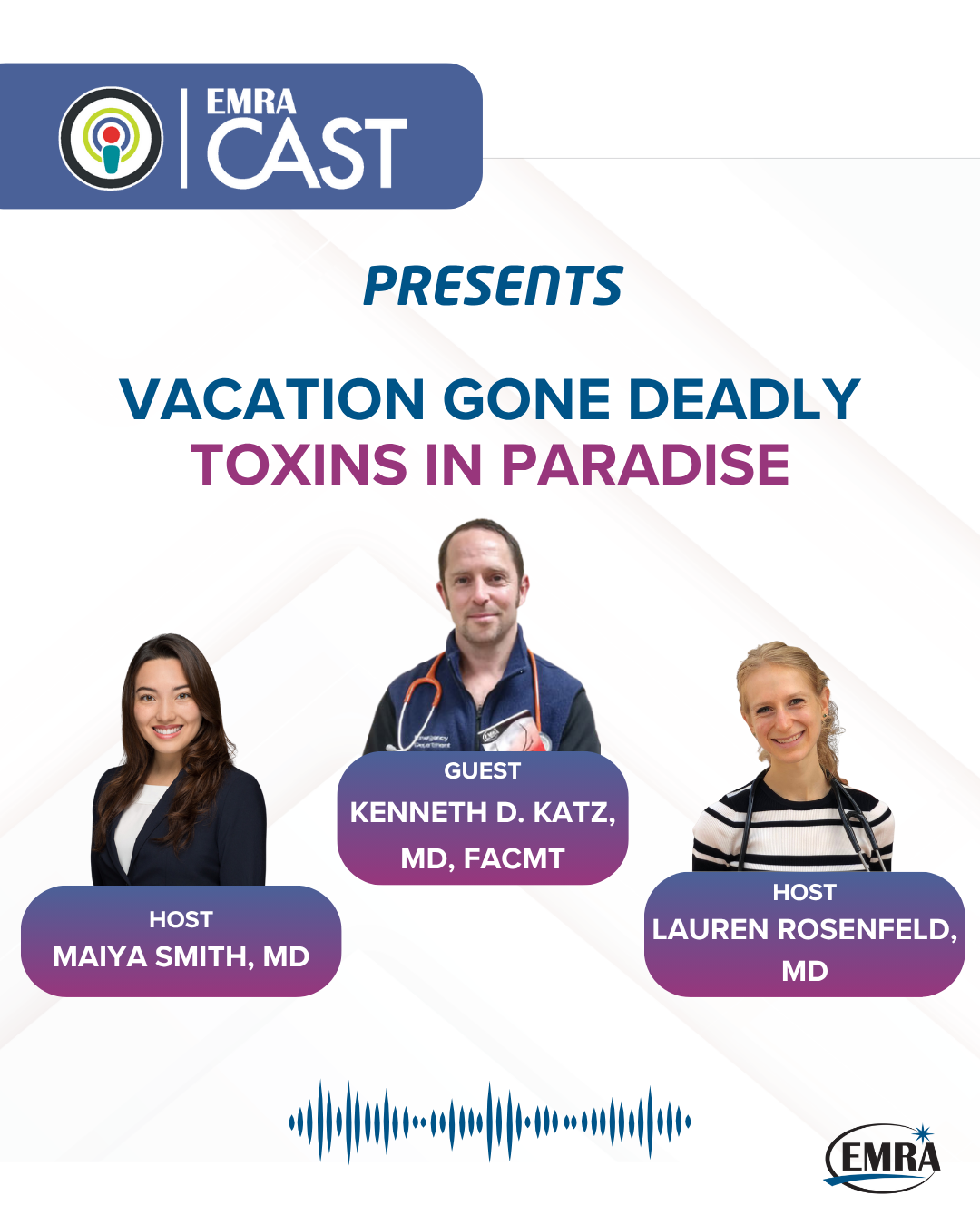Vacation Gone Deadly: Toxins in Paradise
Vacation Gone Deadly: Toxins in Paradise
June 1, 2025
Join EMRA*Cast hosts Maiya Smith, MD, and Lauren Rosenfeld, MD, in this group discussion with toxicologist and EM physician Dr. Ken Katz. Inspired by Season Three of The White Lotus, this episode tackles toxins you might encounter while traveling. Dr. Katz discusses the deadly "suicide tree," pong pong, and also explores other toxins like xylazine and carbon monoxide poisoning.
Hosts
Maiya Smith, MD
University of Utah
Emergency Medicine Residency Class of 2025
@Maiyaandtheadventuremutts
EMRA*Cast Episodes
Lauren Rosenfeld, MD
George Washington University
Emergency Medicine Residency Class of 2026
@laurenatoregon on X; @laurenkrosenfeld on IG
EMRA*Cast Episodes
Guest
Ken Katz, MD, FACEP, FAAEM, FACMT
Editor-In-Chief EMRA Toxiology Guide
Philadelphia College of Emergency Medicine, Professor
Emergency Medicine Physician, Lehigh Valley Health Network
OVERVIEW
In this episode of EMRA*Cast's "Vacation Gone Deadly: Toxins in Paradise," hosts Maiya Smith, MD, and Lauren Rosenfeld, MD, speak with Kenneth Katz, MD, a toxicologist and practicing EM physician at Lehigh Valley Health, about toxins you might encounter while traveling, inspired by Season Three of The White Lotus.
Dr. Katz, editor-in-chief of the EMRA and ACMT Medical Toxicology Guide, discusses pong pong, the fruit of the deadly Cerbera Odollum tree, which contains cardiac glycosides and mimics the acute overdose of digoxin if ingested. We then delve into other common intoxicants that can be found while traveling, both xylazine and carbon monoxide poisoning.
Objectives
- Pong Pong, or the “suicide tree,” is common in Southeast Asia and contains cardiac glycosides. The pathophysiology is similar to digoxin poisoning and can be treated similarly
- Xylazine is a common adulterant found in many opioids and is an Alpha 2 agonist. As its becoming more common, symptoms of both intoxication and withdrawal should both be identified
- Carbon Monoxide poisoning can happen anywhere when traveling, even outside, treatment is mostly supportive care, but always travel with a carbon monoxide monitor for your own safety
References
- Wermuth ME, Vohra R, Bowman N, Furbee RB, Rusyniak DE. Cardiac Toxicity from Intentional Ingestion of Pong-Pong Seeds (Cerbera Odollam). J Emerg Med. 2018;55(4):507-511.
- Perrone J, Haroz R, D'Orazio J, et al. National Institute on Drug Abuse Clinical Trials Network Meeting Report: Managing Patients Exposed to Xylazine-Adulterated Opioids in Emergency, Hospital and Addiction Care Settings. Ann Emerg Med. 2024;84(1):20-28.
- Eichhorn L, Thudium M, Jüttner B. The Diagnosis and Treatment of Carbon Monoxide Poisoning. Dtsch Arztebl Int. 2018;115(51-52):863-870.
- Centers for Disease Control and Prevention (CDC). Carbon monoxide poisonings resulting from open air exposures to operating motorboats--Lake Havasu City, Arizona, 2003. MMWR Morb Mortal Wkly Rep. 2004;53(15):314-318.
- Sanders RW, Katz KD, Suyama J, Akhtar J, O'Toole KS, Corll D, Ladenburger RN. Seizure during hyperbaric oxygen therapy for carbon monoxide toxicity: a case series and five-year experience. J Emerg Med. 2012;42(4):e69-72.





